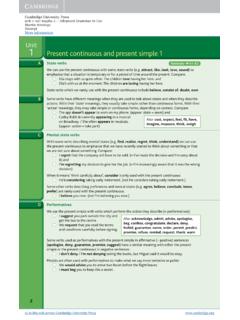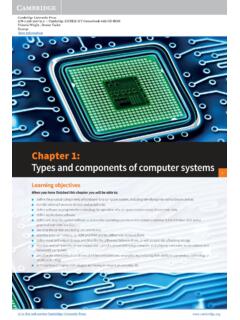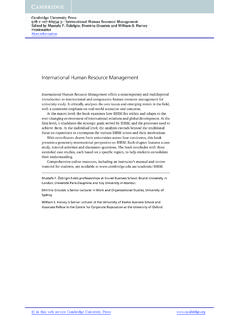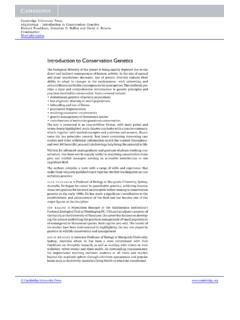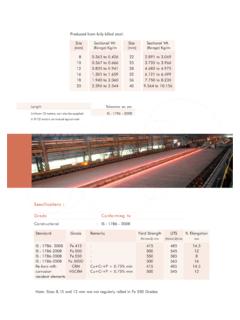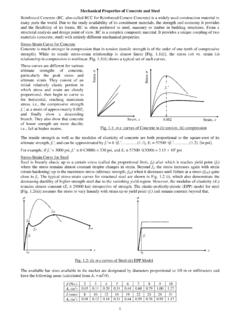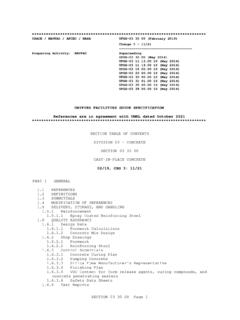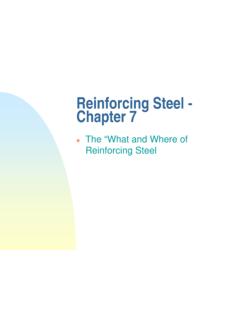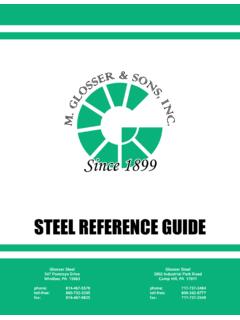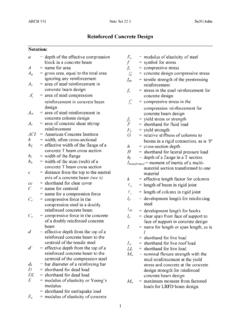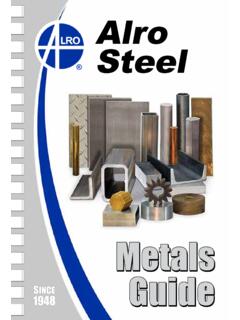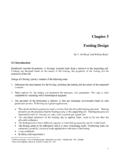Transcription of Materials: Structure, Properties, and Performance
1 Chapter 1 Materials: Structure, properties , and that surrounds us is matter. The origin of the word mat-ter ismater(Latin) ormatri(Sanskrit), formother. In this sense, humanbeings anthropomorphized that which made them possible thatwhich gave them nourishment. Every scientific discipline concernsitself with matter. Of all matter surrounding us, a portion comprisesmaterials. What are materials? They have been variously defined. Oneacceptable definition is matter that human beings use and/or pro-cess. Another definition is all matter used to produce manufac-tured or consumer goods.
2 In this sense, a rock is not a material,intrinsically; however, if it is used in aggregate (concrete) by humans,it becomes a material. The same applies to all matter found on earth:a tree becomes a material when it is processed and used by people,and a skin becomes a material once it is removed from its host andshaped into an successful utilization of materials requires that they satisfy aset of properties . These properties can be classified into thermal, optic-al, mechanical, physical, chemical, and nuclear, and they are in-timately connected to the structure of materials. The structure , in itsturn, is the result of synthesis and processing.
3 A schematic frameworkthat explains the complex relationships in the field of the mechanicalbehavior of materials, shown in Figure , is Thomas s iterative tetra-hedron, which contains four principal elements: mechanical prop-erties, characterization, theory, and processing. These elements arerelated, and changes in one are inseparably linked to changes in theothers. For example, changes may be introduced by the synthesis andprocessing of, for instance, steel . The most common metal, steel hasa wide range of strengths and ductilities (mechanical properties ), whichmakes it the material of choice for numerous applications.
4 While low-carbon steel is used as reinforcing bars in concrete and in the bodyof automobiles, quenched and tempered high-carbon steel is used inmore critical applications such as axles and gears. Cast iron, muchmore brittle, is used in a variety of applications, including automobile Cambridge University University Press978-0-521-86675-0 - Mechanical Behavior of MaterialsMarc Ander Meyers and Krishan Kumar ChawlaExcerptMore information2 MATERIALS: structure , properties , AND PERFORMANCEF orgingRollingStampingDrawingExtrusionCas tingPultrusionChemical vapor depositionPulsed laser ablationMolecular beam epitaxyMetal-Organic CVDL iquid-Phase epitaxyMelt spinningPowder processingMechanical testingOptical microscopyX-ray diffractionScanning electron microscopyScanning probe microscopyAuger electron spectroscopyTransmission electron microscopyCreepFatigueStrengthToughnessD ynamic responseConstitutive responseCharacterizationMechanicalProper tiesProcessingTheoryContinuum mechanicsComputational mechanicsQuantum mechanicsCrystallography.
5 DefectsDiffractionThermodynamicsPhase transformationsElectrochemistryFig. materialstetrahedron applied to mechanicalbehavior of materials. (After )engine blocks. These different applications require, obviously, differ-ent mechanical properties of the material. The different propertiesof the three materials, resulting in differences in Performance , areattributed to differences in the internal structure of the understanding of the structure comes fromtheory. The determina-tion of the many aspects of the micro-, meso-, and macrostructure ofmaterials is obtained bycharacterization. Low-carbon steel has a primar-ily ferritic structure (body-centered cubic; see Section ), with someinterspersed pearlite (a ferrite cementite mixture).
6 The high hardnessof the quenched and tempered high-carbon steel is due to its martens-itic structure (body-centered tetragonal). The relatively brittle castiron has a structure resulting directly from solidification, withoutsubsequent mechanical working such as hot rolling. How does oneobtain low-carbon steel , quenched and tempered high-carbon steel ,and cast iron? By differentsynthesisandprocessingroutes. The low-carbon steel is processed from the melt by a sequence of mechani-cal working operations. The high-carbon steel is synthesized with agreater concentration of carbon (> ) than the low-carbon steel ( ).
7 Additionally, after mechanical processing, the high-carbonsteel is rapidly cooled from a temperature of approximately 1,000 Cby throwing it into water or oil; it is then reheated to an intermedi-ate temperature (tempering). The cast iron is synthesized with evenhigher carbon contents ( 2%). It is poured directly into the molds andallowed to solidify in them. Thus, no mechanical working, except forsome minor machining, is needed. These interrelationships among Cambridge University University Press978-0-521-86675-0 - Mechanical Behavior of MaterialsMarc Ander Meyers and Krishan Kumar ChawlaExcerptMore COMPOSITE, AND HIERARCHICAL MATERIALS3structure, properties , and Performance , and their modification bysynthesis and processing, constitute the central theme of materialsscience and engineering.
8 The tetrahedron of Figure lists the princi-pal processing methods, the most important theoretical approaches,and the most-used characterization techniques in materials selection, processing, and utilization of materials have beenpart of human culture since its beginnings. Anthropologists referto humans as the toolmakers, and this is indeed a very realisticdescription of a key aspect of human beings responsible for theirascent and domination over other animals. It is the ability of humansto manufacture and use tools, and the ability to produce manufac-tured goods, that has allowed technological, cultural, and artisticprogress and that has led to civilization and its development.
9 Mater-ials were as important to a Neolithic tribe in the year 10,000bcasthey are to us today. The only difference is that today more complexsynthetic materials are available in our society, while Neolithic tribeshad only natural materials at their disposal: wood, minerals, bones,hides, and fibers from plants and animals. Although these naturallyoccurring materials are still used today, they are vastly inferior inproperties to synthetic , Composite, andHierarchical MaterialsThe early materials used by humans were natural, and their structurevaried widely. Rocks are crystalline, pottery is a mixture of glassy andcrystalline components, wood is a fibrous organic material with a cel-lular structure , and leather is a complex organic material.
10 Humanbeings started to synthesize their own materials in the Neolithicperiod: ceramics first, then metals, and later, polymers. In the twen-tieth century, simple monolithic structures were used first. The termmonolithiccomes from the Greekmono(one) andlithos(stone). It meansthat the material has essentially uniform properties , monolithic materials can have two or more , they have properties (electrical, mechanical, optical, andchemical) that are constant throughout. Table presents some ofthe important properties of metals, ceramics, and polymers. Theirdetailed structures will be described in Section The differencesin their structure are responsible for differences in properties .

